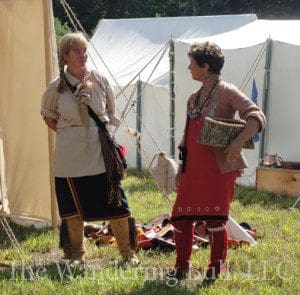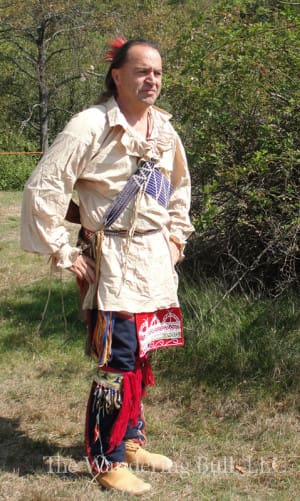
Eastern Woodlands Native American Clothing
Eastern Woodlands Native American Clothing is both functional and decorative. During the pre-contact period, Eastern Native American clothing was made from animal leather and furs. When European trade goods arrived in Northeastern North America, the Native Americans eagerly adopted wool, cotton, linen, ribbons and beads to use for their own clothing. But while they began to use different materials, their clothing style remained essentially unchanged to allow them to move freely in their Woodland environment.
Eastern Woodlands Clothing for Men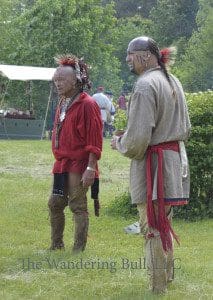
The Eastern Woodlands Native American Clothing for men includes Breechcloths and Leggings. Leggings are basically leather or fabric tubes that covered the lower leg, from above the knee to the ankle. By the 1770s, most Eastern Woodlands Leggings were crafted from wool dyed red, black, or blue. To secure them, a tie extending from the top of the Legging was fastened to a leather belt or wool sash worn around the waist. Additionally, garters were tied just below the knee to ensure the Leggings remained in place throughout wear. Furthermore, sashes were commonly made with finger-woven wool yarn, adding to their traditional craftsmanship. Likewise, garters could be simple leather strips or intricately made with finger-woven wool yarn, reflecting the variety in designs.
The belt or sash also held the Breechcloth in place. The Breechcloth is a long narrow piece of cloth or leather that passes over the belt or sash, between the legs, and over the belt or sash again in the back. This creates the appearance of an apron in the front and back. Breechcloths and Leggings allowed for ease of movement and some European hunters adopted this Native American style of dress.
Eastern Woodlands Clothing for Women
The Eastern Woodlands Native American women wore a wrap skirt usually made from wool. The wool fabric was wrapped around the waist could be tied in place with a leather or twine belt or a finger woven wool sash. Women also wore Leggings made from leather or wool. Because the women’s Leggings were shorter than men’s Leggings, they did not have a tie that attached to a belt at their waist. Women also used leather or finger woven wool Garters tied just below the knee to hold their Leggings up.
What Else Did Eastern Woodlands Native Americans Wear?
People of the Eastern Woodlands commonly wore European trade shirts. White linen or cotton shirts were common, but other colors and patterns were also available. Fancy Ruffled Shirts were highly desirable. By the 1770s, the Eastern Woodlands Natives found that animal furs and skins were more valuable as a trade goods than as material to make clothing.
Leather Center Seam Moccasins were the most common footwear for Eastern Woodlands Native Americans. Center Seam Moccasins are made from a piece of Braintanned Deerskin (or Elk or Moose) that is wrapped around the bottom of the foot and laced together on the top. The leather was sometimes dyed using Black Walnut shell dye. Center Seam Moccasins had flaps at the ankle which could be worn tied up to protect the ankle or left down as loose flaps.
Decorating Eastern Woodlands Native American Clothing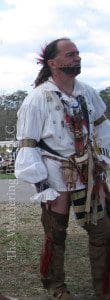
Eastern Woodlands Native Americans decorated their clothing and accessories with a variety of crafting materials. Leather items were decorated with natural pigment paints, Glass Beads and Porcupine Quills. Porcupine Quills are dyed, flattened and attached to the leather in intricate designs. Quillwork is a distinctly Native American craft. Cloth items were decorated with Glass Beads, Trade Brooches and ribbons.
Eastern Woodlands Native American Clothing at The Wandering Bull, LLC
Today, Eastern Woodlands Native American Clothing is worn at social events, like Powwows, and at Native American ceremonies. The Wandering Bull – Native American Trading Post carries a full line of Eastern Woodlands Native American Clothing for the Native community and for our Living History Re-enactor customers.
Select a product and start shopping!
-
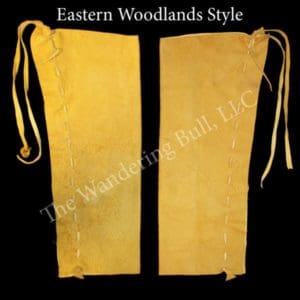
Leggins – Leather Eastern Woodlands Style
$425.00 Add to cart -
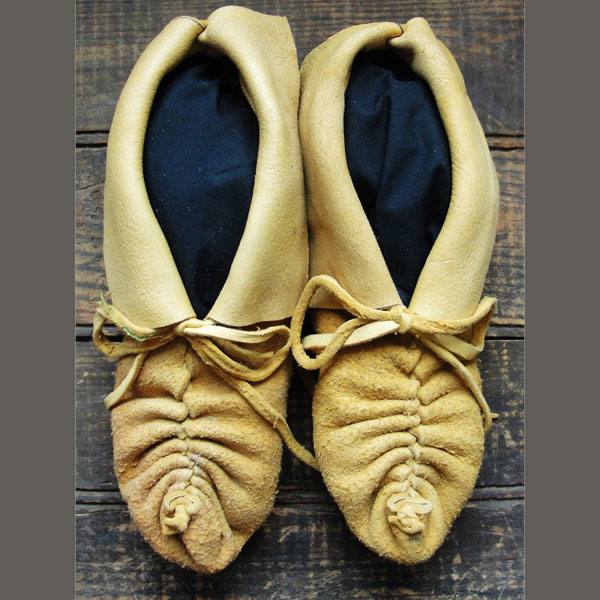
Adult Center Seam Woodlands Moccasin – OUR OWN!
Price range: $125.00 through $175.00 Select options This product has multiple variants. The options may be chosen on the product page -

Assumption Sashes
$31.95 Select options This product has multiple variants. The options may be chosen on the product page

